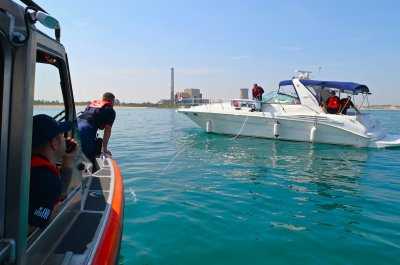| TOP | Archives |
|
SUBSCRIBE: Atom RSS What’s This? |
 |
Photo by Brian Krotser
June 16, 2023
Joint operations event sees active duty and Auxiliary crews prepare for a busy SAR season
By John Saran, AUXPA1, District Captain — Area East, Auxiliary District 9WR
The SAR alarm sounded, beckoning active duty and Auxiliary crews to the Station Michigan City’s communications room. “We have a report of a vessel that just made the trip from New Buffalo to Michigan City and noticed they are missing one passenger. That means you have 1 PIW about a mile offshore and they could be anywhere in that 10-mile stretch. How do you want to proceed, and do you need the assistance of a 45’ RBM?”
These were the instructions and questions provided by the watch stander — Auxiliarist Ed Carroll — and the active duty Officer of the Day to Auxiliarist Paul Bornstein, a coxswain visiting from Chicago during a June 10-11 training exercise at Station Michigan City. Over the course of the two-day event, 25 auxiliarists from Wisconsin, Illinois, Indiana, and Michigan conducted three SAR drills and studied operations policy with their active-duty shipmates. A 45’ RBM, a 29’ RB-S II, one Auxiliary facility from a nearby Michigan City marina and two Auxiliary facilities visiting from Coast Guard Station Chicago all participated in these exercises.
Bornstein was made the on-scene coordinator and provided direction to an active-duty break-in coxswain, BM3 Oscar Garcia, to conduct the search patterns. The search started out with a real-life engine casualty for the RBM, which meant the Auxiliary boat had to proceed on its own. The Auxiliary crew started its track line search and ultimately recovered the person in water (PIW), who happened to be station officer in charge, Chief Petty Officer Steven Klika, in a dry suit. Later that day, BM3 Garcia conducted tow where the scenario vessel suffered a mock fire with PIWs. He had to coordinate with another Auxiliary facility, led by Auxiliarist Josh Zajac, to support his tow and pick up the PIWs. Little did everyone know, BM3 Garcia was having his check ride that he passed with flying colors.
“This was a great way to start the patrol season, and my crew from nearby units in Michiana was ready to jump right into it,” said Auxiliarist Todd Nitz, who coxswained a local Auxiliary facility during the event. His crew started off the exercise with a successful tow of a mock-disabled RB-S II — a task this brand-new facility had not completed before.
After each exercise, the joint crews debriefed, shared chow and engaged in fellowship. “Food is morale and the Aux culinary team kept our crews energized during the exercise. One of my BMs came up to me saying that the Aux are welcome any time, they left the galley cleaner than when they got there,” said Klika.
At the end of the event, Klika and BM1 Anthony Hanusiak provided a preview of new active-duty PQSs involving the RBM and RB-S II available at Station Michigan City for auxiliarists. Station leadership worked with Auxiliary national leadership to develop this pilot program.
“A special thanks to our active-duty shipmates at Station Michigan City. Everybody came together as Team Coast Guard over the course of the weekend,” said Auxiliarist Steve McCarty, commander of the St. Joseph Division.
The 2013 member survey was held from April 25 to May 15. This year's respondents are clearly among the most active and accomplished Auxiliarists. Along with completing the multiple choice section of the survey, members wrote sufficient personal comments to fill a 1,000 page book. The data-dense survey, commissioned by the National Commodore, has been analyzed by the Strategic Planning Directorate and summarized for quick read, along with suggested conclusions and recommendations. The data is presented so anyone who wishes to can study the responses in depth, as well.
[Linda Merryman, DIR-ANACO-PPd]
Whether called the Millennial Generation, the Millennials, Generation Y, or Generation Next, Americans who were born after 1980 are the first in history to have lived their entire lives with technology. Millennials are more individualistic than earlier generations and demand autonomy in their opinions and behavior. They emphasize personal activities above social and labor considerations. By 2025, 75 percent of the global workforce will be millennials; there are 80 million of them in America alone, which is about four million greater than the baby boomer generation. Millennials have different workplace expectations, grew up differently, and want to redefine “work” as we know it. They want to break the rules and corporate hierarchies, and create a lasting impact, starting from day one on the job. How do we blend them into the Auxiliary? See Working with Millennials.
Source [Linda Merryman, ANACO-PPd]
On August 22nd the U.S. Coast Guard Auxiliary District Commodores, Assistant National Commodores, Directors and their deputies, and District Chiefs of Staff participated in a workshop to further discuss the four top items identified from the NTRAIN 2012 brief “Signposts for the Future of the Coast Guard”. The participants identified two common themes across the four discussion topics - succession planning and meeting commitments. They said that leadership is what drives both; and they further suggested a review of leadership training might be in order. There was universal agreement that addressing both of these is critical to the organization.
The report from that session is now available from this link.
Source [Linda Merryman]
The Planning and Performance Directorate website updated with the NTRAIN 2012 Evergreen Report.
At NTRAIN 2012, the Planning and Performance Directorate held a two and one-half hour brief based on the most recent Coast Guard Evergreen findings, called Signposts, for the DCOs and their chiefs of staff, the ANACOs and the directors and their deputies. Their thoughts and comments on presentation points and how they apply to the Auxiliary are in the short report found here.
Source [L. Merryman, ANACO-PPd]